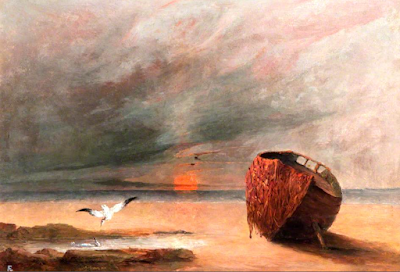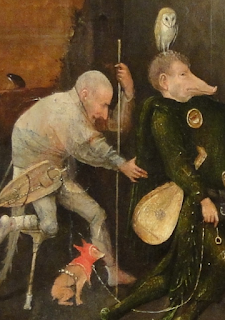 |
| Sunset, by A.E. |
I first encountered the Irish mystic George William Russell, who wrote under the pseudonym A.E., in the pages of
Ulysses, where Stephen Dedalus borrows money from him and then quips, "A.E.I.O.U." I thought that was a pretty good pun but, compared to some of the other work of the greatest punster ever to walk the face of the earth, nothing spectacular.
Only recently (as in this week) have I actually gotten around to reading any of A.E.'s work. I found that in
The Candle of Vision he makes the letters of the alphabet an object of mystical contemplation, considers the vowels separately from the consonants, and takes pains to get the letters in what he considers to be the correct order. Given that the
Candle was published just two years before
Ulysses, and that the two authors knew each other, I can only conclude that the allusion to A.E.'s alphabetical mysticism was deliberate.
So, Joyce, I apologize for having underestimated you here. Despite everything (and there's a lot to forgive!), you were, in your own way, God.
⁂
On pp. 116-118, A.E. explains his project of "brooding upon the significance of separate letters":
I was first led to brood upon the elements of human speech by that whisper of the word "Aeon" out of the darkness, for among many thoughts I had at the time came the thought that speech may originally have been intuitive. I discarded the idea with regard to that word, but the general speculation remained with me, and I recurred to it again and again, and began brooding upon the significance of separate letters, and had related many letters to abstractions or elements . . . . I then began to rearrange the roots of speech in their natural order from throat sounds, through dentals to labials, from A which begins to be recognisable in the throat to M in the utterance of which the lips are closed. An intellectual sequence of ideas became apparent. This encouraged me to try and complete the correspondences arrived at intuitively. I was never able to do this. Several sounds failed, however I brooded upon them, to suggest their intellectual affinities, and I can only detail my partial discoveries . . . .
In the following chapter, he lays out these partial discoveries, which may be summarized thus:
- A: the self, God; a circle
- R: motion; red; a vertical line
- H: heat; orange; a triangle
- L: fire, light, radiation; a shape like an upside-down Y
- Y: binding, concentration, condensation, gravitation, the will; yellow; a triskelion
- W: liquidity, water; green; the lower half of a circle, a smile-like shape
- G: earth; a square
- K: mineral, rock, crystal, hardness; a square crossed by a diagonal, so oriented that the diagonal is vertical
- S: impregnation, inbreathing, insouling, the genesis of the cell; a circle with a horizontal line through the center, like the letter theta
- Z: multiplication, division, reproduction; a circle with a cross in it, like the astronomical symbol for Earth
- TH: growth, expansion, swelling
- SH: scattering, dissolution, decay
- T: individual action, movement, initiative, ego, extroversion; a symmetrical cross, like a plus sign
- D: silence, sleep, immobility, abeyance, inwardness; the upper half of a circle, with a horizontal line joining its ends, like the letter D rotated 90 degrees counterclockwise
- J: --
- TCH: --
- V: life in water, all that swims; blue
- F: what lives in air and flies; blue
- P: masculine life, paternity; indigo
- B: feminine life, maternity; indigo
- N: continuance of being, immortality; violet
- M: close, limit, measure, end, death; violet
A.E. writes, "In all there are twenty-one consonants which with the vowels make up the divine roots of speech. . . . I despair of any attempt to differentiate from each other the seven states of consciousness represented by the vowels." I am not sure why A alone is discussed together with the consonants. At first I had thought it must, like the Hebrew
aleph, represent a glottal stop, but A.E. clearly says that there are 21 consonants, which means A is a vowel.
The selection of sounds, and the order in which he puts them, are highly idiosyncratic. These 22 sounds correspond neither to any alphabet I know of nor to the phoneme inventory of any language with which I am familiar. It appears to be based on the sounds of English, as understood by someone deeply ignorant of phonetics. Many native speakers of English do not realize that there are two different "th" sounds (as in
thy and
thigh, respectively), that the "s" sound in
vision is a distinct sound, or that "ng" is not just a combination of the "n" and "g" sounds.
The placing of R in second place implies that A.E. used a uvular ("guttural") "r" sound, as in French. According to Wikipedia, "A guttural/uvular [ʁ] is found in north-east Leinster. Otherwise, the rhotic consonant of virtually all other Irish accents is the postalveolar approximant, [ɹ]." A.E. was from County Armagh, adjoining north-east Leinster, so it is possible that he spoke this way -- or it could be just another sign of his general confusion regarding where in the mouth different consonants are articulated.
The consonants from 7 to 22 appear in pairs, often but not always representing voiced and voiceless versions of the same sound. Sometimes the voiced sound comes first (G-K, J-TCH, V-F), and sometimes the voiceless (S-Z, T-D, P-B). TH and SH are paired, presumably because A.E. was not aware that each had its own voiced counterpart, and because these two "orphan" fricatives seemed vaguely similar. N and M are paired because they are the only nasal consonants of which he was aware. I surmise that A.E. had no knowledge of the voiced/voiceless distinction but simply put together those consonants that seemed intuitively to be similar in sound.
Despite his use of such terms as "dental" and "labial," and despite his account of how he brooded over these sounds, repeating them to himself again and again, A.E. seems not to have been very clear on what was going on in his mouth when he pronounced them. The sounds are supposed to be organized according to place of articulation, from back to front, but there are many puzzling exceptions. L is an alveolar sound, articulated in the same place as T and D, but it is placed far in the back. When he repeated the L sound to himself, he must have been saying "ull, ull, ull" -- giving the consonant its "dark," velarized pronunciation, rather than the "clear" pronunciation found in "luh, luh, luh." The "dark l" sound is unusual in Hiberno-English but apparently does occur in some Ulster dialects.
The placing of the palatal sound Y in the back, behind the velars, is incorrect but understandable. Since the tongue only comes close to the hard palate without actually touching it, the sound's palatal character is not easy to discover by self-observation. In fact, we can see that A.E. put all approximants in the back, regardless of place of articulation, perhaps because it was not easy to observe how they were pronounced.
The interdental TH and the post-alveolar SH, J, and TCH are also also misplaced, less understandably. (I assume this is
tch as in
Tchaikovsky, thus spelt to differentiate it from
ch as in
Bach.) If you pronounce TH, S, and SH in succession, I think it's pretty easy to observe the tongue moving from the front of the mouth toward the back.
But the most obvious exception is N, which is placed with the labial consonants apparently on the strength of its similarity to M.
⁂
These amateurish errors, together with the incompleteness of the mappings, demonstrate the sincerity with which the project was carried out. I have not the slightest doubt that A.E. did just what he said he did: brooded over these sounds for a long time and wrote down only those correspondences which were confirmed by intuition. Sometimes he didn't get anything (as with TCH and J), and other times his results were only tentative. (Although my summary does not show it, many of the correspondences are qualified with "I think," or "it vaguely suggested itself to me.")
On one level, this whole list of correspondences seems to be obvious nonsense. Aside from the linguistic difficulties, what does it even
mean to say that R corresponds to motion, the color red, and a vertical line? What would follow from such a statement's being true or false? It seems like a classic example of an assertion that is (as Wolfgang Pauli would put it) "not even false." I am reminded of Valentin Tomberg's statement that the traditional planet-metal mappings of astrology (Sun to gold, Moon to silver, Venus to copper, etc.) have been confirmed for him time and again by experience. What sort of experience, I wondered when I read that, could possibly confirm such a thing? What properties of tin unfolded themselves to his understanding when he reflected on the "fact" that tin corresponds to the planet Jupiter? Or what light did tin shed on the nature of Jupiter?
Some of A.E.'s mappings did ring true, but it's hard to be sure why. For example, when I read about F ("what lives in air and flies"), I thought of English
fly, flap, flutter, fowl, and
feather; of Chinese
fēi and Hebrew
'af, both meaning "fly"; and of T. H. White's geese singing "Free, free: far, far: and fair on wavering wings" -- but of course this is just picking cherries, and most flight-related words in most languages do not feature the "f" sound. Does the abundance of such words in English mean that Anglophones have historically been particularly sensitive to the "true" meaning of their consonants? Do Anglophones think "better" or more clearly about flight because they call it
flight? Is that why it was the English-speaking Wright brothers who invented the airplane? (On the other hand, the Montgolfier and Breguet brothers were French, and the great American ornithologist Audubon was born Jean Rabin in French-speaking Saint-Domingue.) Or, more likely, are A.E.'s intuitions unconsciously influenced by the vocabulary of his native language? One feels that the influence of English is also at play in A.E.'s mapping of R to red and Y to yellow. (Both of those mappings were found to be particularly common in Sean Day's survey of 43 colored-letter synesthetes,
qv; Day regrettably neglected to record the languages spoken by his subjects.)
Still, despite these very deep misgivings, both about the general meaningfulness of the questions A.E. was asking and about the validity of his specific answers, I found that I reacted to many of his mappings with delight, and with a sense that, somehow and for some reason, his project was after all worth doing. I suppose what I am reacting to, more than to anything specific, is the general attitude of taking things seriously, of refusing to take arbitrariness and meaninglessness as the null hypothesis.
⁂
Incidentally, the bit about the alphabet is only a few pages long; the bulk of
The Candle of Vision is a serious and sustained meditation of the phenomena of imagination and clairvoyance and on what they mean. It's definitely something I'll be rereading.















